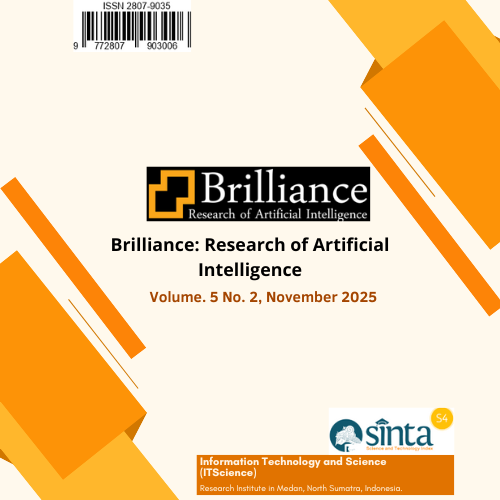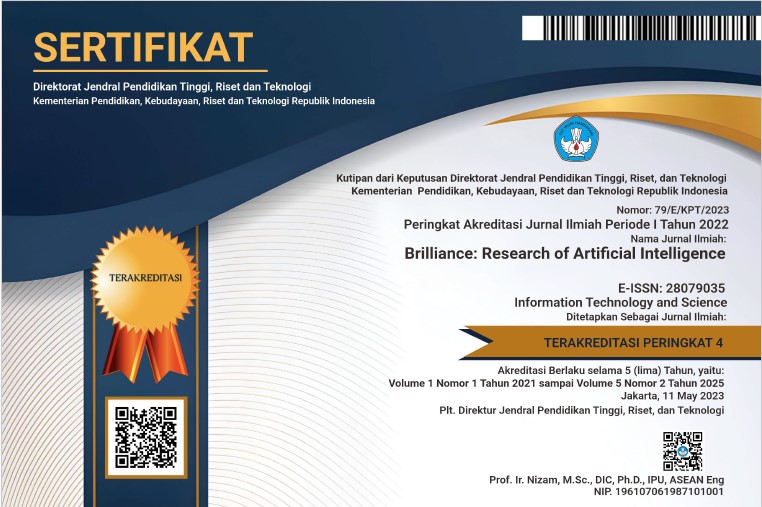The Use of Photodiode Sensors to Detect Sugar Levels in the Human Body
DOI:
https://doi.org/10.47709/brilliance.v5i2.6318Keywords:
Arduino Nano, diabetes mellitus (DM), Glucose Monitoring, Non-invasive, Photodiode SensorAbstract
Diabetes mellitus is a chronic metabolic disorder characterized by elevated blood glucose levels due to impaired insulin production or utilization. Regular monitoring of blood glucose is essential to prevent long-term complications such as neuropathy, nephropathy, retinopathy, and cardiovascular disease. However, conventional finger-prick glucometer methods, while accurate, are invasive, cause discomfort, and often discourage patients from performing frequent checks. To address this limitation, this study presents the design, implementation, and evaluation of a non-invasive glucose monitoring system utilizing a photodiode sensor in conjunction with a near-infrared (NIR) light source operating at wavelengths of 1600–1700 nm. The system architecture comprises an NIR LED as the light emitter, a photodiode as the optical receiver, an Arduino Nano microcontroller for data acquisition and signal processing, and an OLED display for real-time result presentation. During measurement, the user’s fingertip is placed between the LED and photodiode, allowing light to pass through the tissue. Variations in glucose concentration affect the absorption and scattering of NIR light, altering the intensity received by the photodiode. This analog voltage output is digitized using the Arduino’s ADC and converted into glucose levels through a calibration curve derived from reference readings taken using a commercial glucometer. Experimental evaluation was conducted on five human subjects under two physiological conditions—before meals (preprandial) and after meals (postprandial). Each condition was measured three times to minimize variability caused by movement or environmental light interference. The photodiode sensor readings were compared against glucometer results to assess accuracy. The system achieved an average accuracy of 87.1%, with individual measurements ranging from 79.2% to 96.9% before meals and 88.9% to 98.2% after meals. Statistical analysis revealed a mean absolute error (MAE) of 9.83 mg/dL and a correlation coefficient (R²) of 0.934, indicating a strong linear relationship between the two measurement methods. Notably, the system tended to slightly overestimate glucose levels before meals and underestimate them after meals, which may be attributed to physiological variations and optical path differences. The results demonstrate that the proposed photodiode-based NIR sensing system is a promising, low-cost, and user-friendly alternative to conventional invasive glucose monitoring. With further improvements in calibration algorithms, sensor placement stability, and ambient light shielding, this approach has the potential to be integrated into wearable devices, enabling continuous glucose tracking and improving patient adherence to self-monitoring routines.
References
Belfarsi, M., et al. (2025). Deep learning for non-invasive biosensor analysis. AI in Biomedical Engineering, 12(1), 55–62.
Budiarti, E. (2017). Prototipe alat ukur kadar gula darah secara non-invasive berbasis Arduino Uno. Universitas Semarang.
Di Filippo, M., et al. (2023). NIR wavelengths and glucose correlation. Biomedical Signal Processing, 8(4), 212–218.
DiMatteo, M. R. (2004). Variations in patient’s adherence to medical recommendation: A quantitative review of 50 years of research. Medical Care, 43(3), 200–209.
Hoffman, K., & Mather, P. (2022). Using infrared spectroscopy for diabetes detection. Journal of Biomedical Optics, 27(9), 095001.
Khairina, N., & Harahap, M. K. (2020). Menjaga kerahasiaan data dengan steganografi kombinasi LSB-2 dengan LSB-3. SinkrOn – Jurnal & Penelitian Teknik Informatika, 3(1), 286–288.
Khairina, N., Harahap, M. K., & Lubis, J. H. (2018). The authenticity of image using hash MD5 and steganography least significant bit. International Journal of Information System & Technology, 2(1), 1–6.
Lee, H., & Kim, Y. (2021). Development of wearable photonic sensors for health monitoring. Sensors, 21(3), 1032.
Matheus, D. H., Periyadi, & Rosmiati, M. (2021). Perancangan dan implementasi alat pengukur gula darah dan tekanan darah berbasis Arduino. Jurnal Teknik Elektro, 7(6), 2890–2893.
Moses, J., et al. (2024). Integrating biosensors in wearable health systems. IEEE Biomedical Circuits, 9(2), 99–107.
Palandeng, H. M. (2015). Prevalensi hipertensi dan diabetes mellitus tipe-2 di Puskesmas Kota Manado tahun 2015. Jurnal Kedokteran Komunitas dan Tropik.
Putri, S. Y., & Firmawati, N. (2022). Rancang bangun pengukur kadar gula darah non-invasive berbasis NodeMCU ESP8266. Jurnal Fisika Unand, 11(2), 271–277. https://doi.org/10.25077/jfu.11.2.271-277.2022
Roth, C. A., & Schade, L. M. (2020). Advances in photodetector sensors for biomedical applications. Biomedical Optics Express, 11(6), 2985–2999.
Suyono, H., & Hambali, H. (2020). Perancangan alat pengukur kadar gula dalam darah menggunakan teknik non-invasive berbasis mikrokontroler Arduino Uno. JTEV (Jurnal Teknik Elektro dan Vokasional), 6(1), 69. https://doi.org/10.24036/jtev.v6i1.107482
Yang, L., Zhang, T., & Chen, X. (2024). Near-infrared photodiode sensing for continuous non-invasive glucose monitoring: Challenges and opportunities. IEEE Transactions on Biomedical Circuits and Systems, 18(2), 123–130. https://doi.org/10.1109/TBCAS.2024.1234567
Downloads
Published
How to Cite
Issue
Section
License
Copyright (c) 2025 Muharratul Mina Rizky, Depi Ginting, T Sukma Achriadi Sukiman

This work is licensed under a Creative Commons Attribution-NonCommercial 4.0 International License.


















